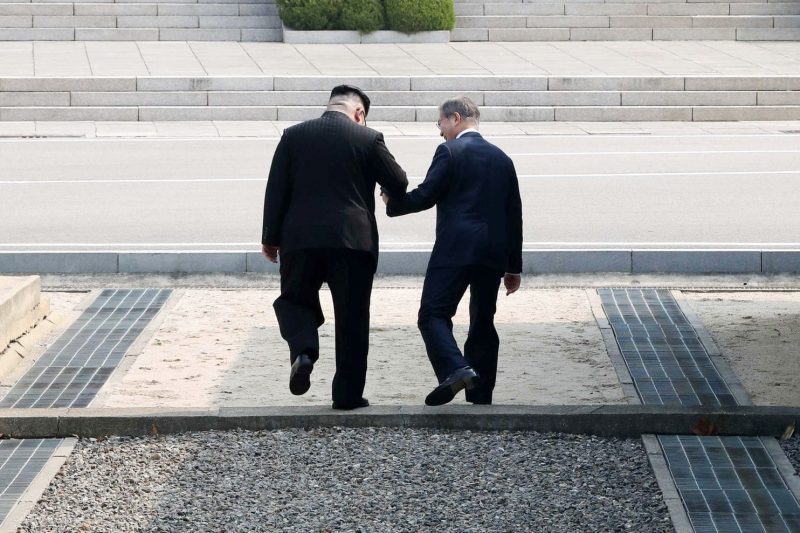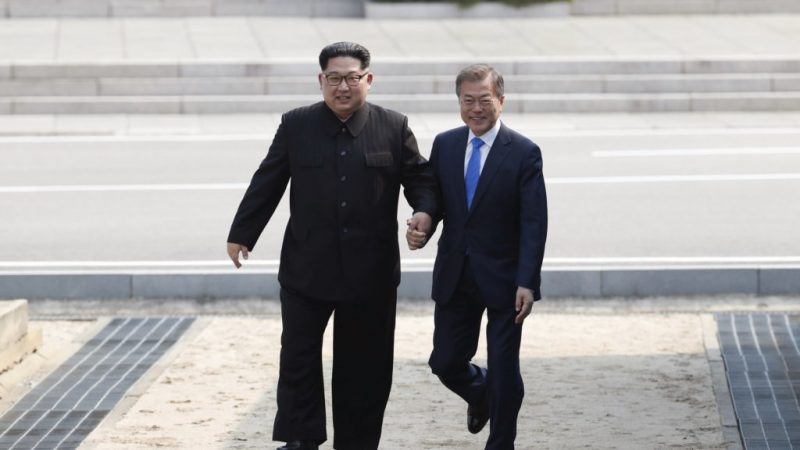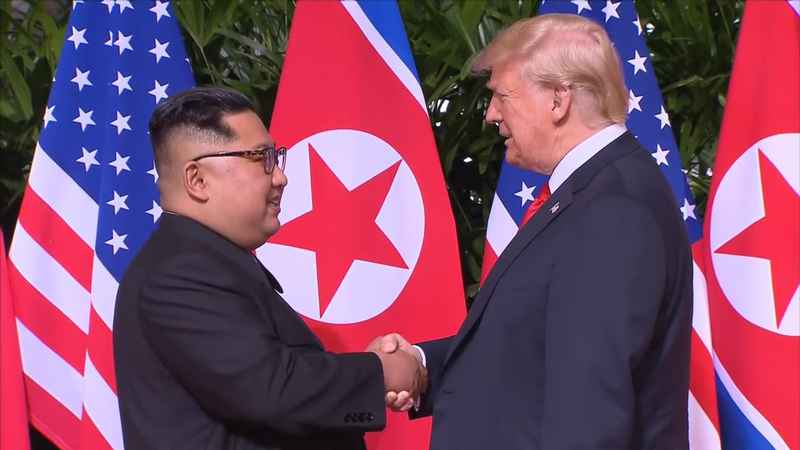 North Korean leader Kim Jong Un (left) and South Korean President Moon Jae-in hold hands as they cross the Military Demarcation Line (MDL) to the Northern side of the border at the village of Panmunjom in the Demilitarized Zone (DMZ) in Paju, South Korea, April 27, 2018. (Inter-Korean Summit Press Corps/Bloomberg)
North Korean leader Kim Jong Un (left) and South Korean President Moon Jae-in hold hands as they cross the Military Demarcation Line (MDL) to the Northern side of the border at the village of Panmunjom in the Demilitarized Zone (DMZ) in Paju, South Korea, April 27, 2018. (Inter-Korean Summit Press Corps/Bloomberg)
Here’s one New Year’s resolution that should be easy: The United States and North Korea should resume the diplomatic progress they began in 2018 toward peace and denuclearization.
It’s a measure of this year’s turbulent pace that the Singapore summit between President Trump and Chairman Kim Jong Un just six months ago now seems a distant memory. The promise of that meeting disappeared soon after it took place, in a stalemate that led many analysts to question whether Kim had ever been serious about giving up nuclear weapons.
Perhaps the North Korean opening will turn out to be a hoax, as critics have argued, but it’s too soon to make that judgment. The priority for now should be to transform the promises made in Singapore into verifiable steps toward “complete denuclearization” and “a lasting and stable peace regime.”
The Trump administration has been sending the right signals lately. Stephen Biegun, the special representative for North Korea, offered a small but symbolic concession on Dec. 19 in Seoul, when he said Washington would review its ban on U.S. travel to North Korea to ease humanitarian aid to that country.
Trump amplified the positive message with a Dec. 24 tweet that showed him with Biegun and National Security Council aide Allison Hooker: “Christmas Eve briefing with my team working on North Korea — Progress being made. Looking forward to my next summit with Chairman Kim!”

Trump’s offer to meet again with Kim is one of the puzzle pieces for 2019. “Counting on it” is how Secretary of State Mike Pompeo described the planned second summit in a Dec. 20 interview with NPR’s Steve Inskeep. “There remains a long ways to go but we are, we are hard at it, even today,” Pompeo said.
“I want to reiterate that the future can be very bright for North Korea if it makes good on its commitment to final, fully verified denuclearization. It will lead to . . . greater prosperity for the North Korean people, and to an enduring peace,” Pompeo told the United Nations back in September.
The administration’s recent gestures are clearly meant to coax a reciprocal response from Kim. For months, Washington has been waiting for a clear road map toward denuclearization; without it, a second installment of the showy Singapore-style summitry may backfire.
Kim’s answer may come in his annual New Year’s Day speech.
Recent North Korean statements have stressed that, in North Korea’s view, the Singapore communique’s commitment to “work toward complete denuclearization of the Korean Peninsula” doesn’t refer just to the North’s weapons but to U.S. weapons that could threaten Pyongyang.
Some of these statements have been hard-edged, but there has been no sign that Kim is planning to make a U-turn.
“If he chooses not to lead us on a merry chase through the rhetorical brambles, but to be fairly straightforward on engaging the U.S. . . . we might see a bit of traction soon,” says one prominent Korea watcher of Kim’s speech next Tuesday.
Domestic support for the Singapore framework matters now, when Democrats are about to take control of the House and Trump’s broader foreign policy is under fire. Skepticism about Kim’s promises is certainly warranted given the diplomatic gridlock since Singapore.
But even Trump’s sharpest critics should agree that backsliding into military confrontation would be a mistake.
“How do you build a floor under the accomplishments that have been made so far, so that they aren’t washed away?” asks Robert Carlin, a former CIA and State Department analyst who has visited North Korea more than two dozen times.

He fears that the commitments Trump and Kim made in Singapore could collapse as quickly as did the Clinton administration’s 1994 “Agreed Framework” with North Korea after Republicans gained the White House in 2001.
What needs to be preserved, above all, is the halt in North Korean nuclear and missile testing. Pompeo highlighted this centerpiece last week in the NPR interview: “They’re not firing rockets. They’re not conducting nuclear tests.” Any resumption of North Korean testing could have disastrous results.
Impatience and bombast have been hallmarks of Trump’s foreign policy. But he evidently views the diplomatic opening with North Korea as a “win” for his presidency, and he’s willing to wait on the details. As Pompeo put it to NPR, people shouldn’t expect “instant pudding.” But at some point, the pudding needs to harden, or it will just be mush.
Trump got many things wrong in foreign policy this past year. But he made the right start on North Korea, and sensible people should hope that his dialogue with Kim will deepen into a real transformation of the Korean Peninsula.
By David Ignatius, The New York Times
https://www.washingtonpost.com/opinions/one-new-years-resolution-continuing-the-us-north-korea-dialogue/2018/12/27/f6ba2ae4-0a22-11e9-a3f0-71c95106d96a_story.html?utm_term=.3f3f69d5d56f
The 21st Century
